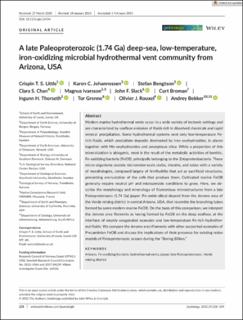| dc.contributor.author | Little, Crispin T.S. | |
| dc.contributor.author | Johannessen, Karen Cecilie | |
| dc.contributor.author | Bengtson, Stefan | |
| dc.contributor.author | Chan, Clara S. | |
| dc.contributor.author | Ivarsson, M. | |
| dc.contributor.author | Slack, John F. | |
| dc.contributor.author | Broman, Curt | |
| dc.contributor.author | Thorseth, Ingunn Hindenes | |
| dc.contributor.author | Grenne, Tor | |
| dc.contributor.author | Rouxel, Olivier J. | |
| dc.contributor.author | Bekker, Andrey | |
| dc.date.accessioned | 2022-03-11T12:00:08Z | |
| dc.date.available | 2022-03-11T12:00:08Z | |
| dc.date.created | 2021-06-02T12:31:26Z | |
| dc.date.issued | 2021 | |
| dc.identifier.issn | 1472-4677 | |
| dc.identifier.uri | https://hdl.handle.net/11250/2984623 | |
| dc.description.abstract | Modern marine hydrothermal vents occur in a wide variety of tectonic settings and are characterized by seafloor emission of fluids rich in dissolved chemicals and rapid mineral precipitation. Some hydrothermal systems vent only low-temperature Fe-rich fluids, which precipitate deposits dominated by iron oxyhydroxides, in places together with Mn-oxyhydroxides and amorphous silica. While a proportion of this mineralization is abiogenic, most is the result of the metabolic activities of benthic, Fe-oxidizing bacteria (FeOB), principally belonging to the Zetaproteobacteria. These micro-organisms secrete micrometer-scale stalks, sheaths, and tubes with a variety of morphologies, composed largely of ferrihydrite that act as sacrificial structures, preventing encrustation of the cells that produce them. Cultivated marine FeOB generally require neutral pH and microaerobic conditions to grow. Here, we describe the morphology and mineralogy of filamentous microstructures from a late Paleoproterozoic (1.74 Ga) jasper (Fe-oxide-silica) deposit from the Jerome area of the Verde mining district in central Arizona, USA, that resemble the branching tubes formed by some modern marine FeOB. On the basis of this comparison, we interpret the Jerome area filaments as having formed by FeOB on the deep seafloor, at the interface of weakly oxygenated seawater and low-temperature Fe-rich hydrothermal fluids. We compare the Jerome area filaments with other purported examples of Precambrian FeOB and discuss the implications of their presence for existing redox models of Paleoproterozoic oceans during the “Boring Billion.” | en_US |
| dc.language.iso | eng | en_US |
| dc.publisher | Wiley | en_US |
| dc.rights | Navngivelse 4.0 Internasjonal | * |
| dc.rights.uri | http://creativecommons.org/licenses/by/4.0/deed.no | * |
| dc.title | A late Paleoproterozoic (1.74 Ga) deep-sea, low-temperature, iron-oxidizing microbial hydrothermal vent community from Arizona, USA | en_US |
| dc.type | Journal article | en_US |
| dc.type | Peer reviewed | en_US |
| dc.description.version | publishedVersion | en_US |
| dc.rights.holder | Copyright 2021 The Authors | en_US |
| cristin.ispublished | true | |
| cristin.fulltext | original | |
| cristin.qualitycode | 2 | |
| dc.identifier.doi | 10.1111/gbi.12434 | |
| dc.identifier.cristin | 1913272 | |
| dc.source.journal | Geobiology | en_US |
| dc.source.pagenumber | 228-249 | en_US |
| dc.identifier.citation | Geobiology. 2021, 19 (3), 228-249. | en_US |
| dc.source.volume | 19 | en_US |
| dc.source.issue | 3 | en_US |

